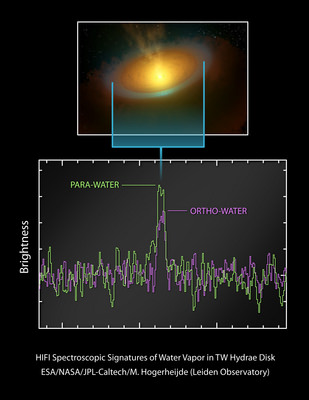[/caption]
There’s enough water in a planet-forming disk around a distant star to fill several thousand Earth oceans, according to new observations with the Herschel space observatory. Astronomers have found evidence of water vapor originating from ice on dust grains in the disc around a young star, TW Hydrae. The star is between 5-10 million years old, so is in its final stages of formation.
“The detection of water sticking to dust grains throughout the disc would be similar to events in our own Solar System’s evolution, where over millions of years, similar dust grains then coalesced to form comets,” said Michiel Hogerheijde of Leiden University in the Netherlands, who led the study. “These comets we believe became a contributing source of water for the planets.”
Herschel has found water around other stars, such as an old red giant star CW Leonis, and other telescopes like Spitzer have also observed abundant water in nascent planet forming regions around other stars.
But scientists say this latest research from Herschel breaks new ground in understanding water’s role in planet-forming discs and gives scientists a new testing ground for looking at how water came to our own planet.
“With Herschel we can follow the trail of water through all the steps of star and planet formation,” said Göran Pilbratt, Herschel Project Scientist at ESA.
Scientists think the water vapor signature is produced when the ice coated dust grains are warmed by interstellar UV radiation.
Read more on this discovery at the ESA Herschel website.


just amazing…
we like to hear it!
ive been thinking all along that life could form in space in an environment like this
NASA tether incident looked like a life form not a craft also would make sense communication would be via light, extreme environments would be on planets and i see space as a medium
Cool as ice.
Recent observations of comet isotope ratios allows bodies originating in the innermost disk having delivered more than 20 % of Earth water (the earlier limit). But that same observation makes the terrestrial planetesimals members of a more continuous water distribution.
That leaves room for massive amounts of native water and organics on planets before the ~ 4.1 – 3.8 Ga bp LHB. Coincidentally, Jack Hill zircon finds suggesting such water and organics ~ 4 Ga bp seems to concur.
Which is good, because LHB planetary system dynamics may be relatively rare.